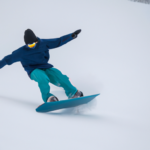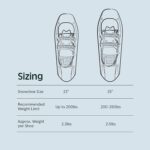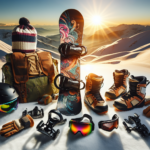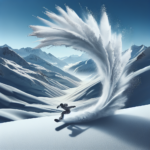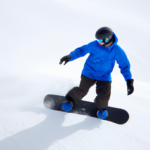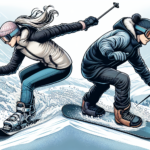Sometimes, the thought of strapping yourself to a board and shooting down a snowy hill can be a tad nerve-wracking. If that’s how you’re feeling, don’t fret! The article “How To Snowboard Tips?” is just the guide you need. It’s brimming with a wealth of knowledge that will help you understand how to get started, maintain balance, execute turns, and master other fundamental skills of snowboarding. Plus, it’s crafted so that it’s easy to comprehend, regardless of your experience level. This way, you’re not only learning the art of snowboarding, but you’re also loving every second of it.
Understanding the Basics of Snowboarding
It’s great that you’ve decided to embark on the exhilarating journey into the world of snowboarding. But before you hit the slopes, it’s essential to grasp the basic principles of this winter sport and understand what you’re setting yourself up for.
Knowing your stance
Snowboarding isn’t simply about having the guts to ride down a snowy slope; it’s also about knowing your stance. You could either be regular (left foot in front) or goofy (right foot in front). You don’t choose your snowboarding stance; it chooses you. It typically aligns with the foot you naturally put forth when you’re about to take a step or catch yourself from falling. Spend some time to understand which foot you lead with; you’ll need this information when setting up your snowboard.
Familiarizing with snowboarding equipment
You’re going to be strapped to your snowboard, figuratively and literally. It’s crucial to familiarize yourself with your equipment. Understand the parts of a snowboard – the deck, the bindings, the boots. Get comfortable with fitting your boots into your board’s bindings and clasping them securely. Learn how to handle your snowboard, carry it correctly, and rest it safely when not in use.
Choosing the right snowboard
There’s no one-size-fits-all in snowboarding. When choosing your snowboard, several factors come into play – your skill level, your weight, your riding style, and the type of snowboarding you plan on doing. The length and width of your board, its flex, the shape of its tip and tail, the characteristics of its sidecut—it all matters. Take your time researching and finding the right snowboard that fits you well.
Getting Comfortable on Your Snowboard
Once you’ve got your gear ready, the next step is learning to get comfortable on your snowboard. Believe it or not, this can be the trickiest part for beginners.
Strapping into your snowboard
Getting into your bindings properly is the first step to successfully snowboarding. You do this by first placing your front foot (based on your determined stance) into the front binding, strapping it in, then doing the same for your back foot. Ensure your feet are snug but comfortable. Practice this off the slope first to get the hang of it.
Standing up on a snowboard
Next, you’ll need to get up on your board. Remember, always get up sideways, never try to stand straight up. Face your board downhill, plant your hands in the snow, and lift your body into a standing position. It may seem difficult at first, but with practice, you’ll find your groove.
Finding your balance
Now that you’re up, it’s time to find your balance. Feel the board beneath your feet, bend your knees slightly, and maintain an upright body position. This is your neutral stance. You should be able to shift your weight forward, backward, and from side to side without falling. Practice this until you feel confident staying balanced on your board.
Mastering the Basic Moves
Once you’re comfortable standing and balancing on your snowboard, it’s time to get moving.
Practicing skidding
Skidding or stopping is one of the first moves you need to master. Begin by applying pressure through the heel of your leading foot, tipping the snowboard up slightly, and creating resistance against the snow to slow down your momentum. It’s essential to get confident with this move, it’s going to help you control your speed, and importantly, stop you from crashing!
Learning to turn
Turning on a snowboard involves shifting your body weight and making use of your edges. There are two basic turns you need to learn – heel-side turns and toe-side turns. Practice shifting your weight and moving your board while still retaining balance. Remember, it’s all about the slight movements; snowboarding is not about making huge weight shifts.
Understanding edging
Edging is about controlling the tilt of your snowboard. You use your edge to make sharp turns and to control how fast you go. It can be tricky at first, but once you’ve got the hang of it, you’ll find yourself making smoother turns and maintaining speed control more effectively.
Learning Advanced Snowboarding Techniques
Once you’re confident and have mastered the basic moves, you can start learning some cooler, more advanced techniques.
Carving on a snowboard
Carving is a snowboarding technique that allows you to make clean turns without sliding your board. This technique uses the edges of your snowboard to cut into the snow, like a hot knife through butter. With good carving technique, you’ll make beautiful turns and maintain better control of your speed.
Practicing jumps and tricks
Once you’ve got carving down, you might want to explore some more exciting prospects – jumps and tricks. Start off with small jumps and gradually work your way up. As for tricks, remember always to wear protective gear, and maybe even consider hiring a coach to ensure you learn the right techniques in a secure manner.
Mastering steep terrain snowboarding
Steep terrain snowboarding is not for the faint-hearted, but once you’ve honed your skills on groomed runs, you might be ready for this challenge. It allows you to push your boundaries and test your skills in diverse and exhilarating ways. Just remember, always start small and gradually work your way onto steeper terrain.
Improving Your Speed and Agility
As you develop your snowboarding skills, your speed and agility will inevitably improve. Still, there are a few techniques you can use to speed up this process.
Controlling your speed
Speed is a significant aspect of snowboarding. Maintaining control at high speeds is both challenging and thrilling. It’s a gradual learning process that involves a good understanding of carving and edging, as well as an awareness of your surroundings.
Improving your agility
Your agility on a snowboard is linked to how quickly and efficiently you can execute turns, dodge obstacles, and maintain balance irrespective of the terrain or speed. Practicing different types of turns, working on your core strength, and attempting various snowboarding styles can help improve your agility.
Learning quick turns and transitions
Being able to make quick turns is a valuable skill to have on the slopes. This will allow you to navigate through challenging terrains and avoid obstacles at high speeds—a must-have skill for any serious snowboarder. Each turn should feel smooth and be carried out with precision.
Preventing and Handling Accidents or Falls
Falls and accidents are inevitably a part of snowboarding. They’re how you learn. But it’s vital to minimize the risk of severe injuries and know how to handle them if they occur.
Learning how to fall correctly
Believe it or not, there’s a right way to fall. Here’s a quick tip: Try not to fall flat on your face or back; roll onto one side instead. Always keep your limbs relaxed. Tensed muscles can lead to more serious damage.
Dealing with accidents
In case of an accident, the most important thing to remember is not to panic. If you’ve been injured, seek professional medical help immediately.
Understanding signs of danger
Snowboarding is fun but remember that you’re at the mercy of Mother Nature. Always keep an eye on the weather, especially when snowboarding in backcountry areas. Know and respect avalanche warnings. Carry essential gear like a beacon, shovel, and probe when venturing into risky zones.
Adhering to Snowboarding Safety Guidelines
Safety should be your number one priority when snowboarding. This not only includes wearing appropriate gear but also practicing good etiquette and abiding by the rules.
Wearing appropriate safety gear
A helmet, snow goggles, snowboard boots, wrist guards, and body armor can protect you from severe injuries. Invest in high-quality gear and faithfully wear it every time you hit the slopes.
Practicing snowboarding etiquette
Good snowboarding etiquette ensures everyone’s safety on the slopes. This includes things like giving right of way to people ahead of you, not stopping in blind spots, and helping others in need.
Knowing the rules of the snowboarding area
Each snowboarding area has its own set of rules meant to keep all riders safe. Make sure you’re aware of and abide by these rules. When in doubt, always ask!
Staying Fit and Prepared for Snowboarding
Staying physically fit and adequately prepared can help you get the most out of your snowboarding experience.
Maintaining snowboarding fitness
Snowboarding works various muscles in your body. Regular workouts focusing on your core, flexibility, and leg strength can help maintain your snowboarding fitness.
Understanding the importance of warm-up and cool-down
Never underestimate the importance of a good warm-up and cool-down. They prepare your body for physical exertion and help prevent muscle soreness and injury.
Staying hydrated and nourished
Staying hydrated and nourished is essential when you’re physically active. Carry water with you and eat a balanced meal before hitting the slopes to maintain your energy levels.
Facing and Overcoming Challenges in Snowboarding
Snowboarding is a sport that comes with various challenges. Here’s how you can face them:
Dealing with difficult weather conditions
Unpredictable weather is a common challenge. Check the forecast before you set off, dress appropriately, and be prepared to adjust your plans if necessary.
Overcoming fear and mental blocks
Fear and mental blocks are common in snowboarding. Visualization, deep breathing techniques, and gradual exposure can help you overcome these obstacles.
Handling challenging terrains and obstacles
Challenging terrains and obstacles are part of the package. Master the basics, improve your agility, plan your route, and, most importantly, be patient with yourself.
Enhancing Your Snowboarding Experience
Here are a few tips to enhance your experience as you advance in your snowboarding journey.
Exploring different snowboarding styles
From freestyling to freeriding, alpine, and off-piste, there’s a wide range of snowboarding styles to explore. Each offers unique challenges and rewards, improving your skills and keeping snowboarding exciting.
Joining snowboarding communities
Whether it’s joining an online forum or a local snowboarding club, being part of a community gives you a sense of belonging, allows for shared experiences, and enables you to learn from others.
Participating in snowboarding events and competitions
Snowboarding events and competitions are a great way to test your skills, learn from others, and add an exciting dimension to your snowboarding experience.
That’s it, folks! Time, practice, and patience are your best friends on this snowboarding journey. Remember, it’s about enjoying the ride—powdery snow, clear skies, and all.
- What Snowboard Bindings Should I Get? - January 23, 2024
- What Size Screws For Snowboard Bindings? - January 23, 2024
- How To Snowmobile On Water? - January 23, 2024

